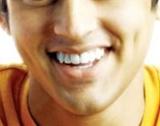Health Topics
-
Healthy Living
-
|
| |
| Care Options for Your Pearly Whites |
|
Vijay Ghosh
|
| (Continued...) |
| |
Perfect teeth
Let us face the facts. Most people aren’t born with perfect teeth. There may be many irregularities such as crooked teeth or overcrowded teeth that can make a beautiful smile look like a grimace. Fortunately, help is at hand in the form of orthodontics. This is a specialized branch of dentistry that deals with the correction of crowded and crooked teeth to produce a natural and regular arrangement. There are many tooth shaping techniques that an orthodontist may use to ensure that you have a perfect set of thirty two teeth growing in a straight line. |
| |
 |
Braces: Braces come in many shapes and varieties and are used to ensure that teeth grow in a regular manner. Braces may have to be worn for a period ranging from one to three years. Although braces are normally used on teenagers, they can also be successfully used on adults. Braces are not only used to provide cosmetic improvements but can also be used to provide relief from symptoms such as jaw joint pain. |
| |
| Crowns and Bridges: Crowns and bridges are used when a tooth has become so badly damaged that other cosmetic options are unviable. In such a circumstance, a crown or bridge is a perfect alternative. This is an artificial tooth (crown) or set of teeth (bridge) that is fitted over your damaged teeth. It not only looks good, but also enables you to chew your food painlessly. Crowns or bridges may be made of metal, porcelain or cast glass. |
| |
Braving the dentist’s chair
More often than not, a visit to the dentist is precipitated by a serious problem, such as an acute tooth ache. Many people are still so scared of the thought of the dentist’s chair that they wait until the last possible moment to consult a dentist. This is the best way to ensure that you ruin a perfectly healthy set of teeth. Most problems can be very easily and painlessly resolved if you seek a dentist’s help in a timely manner. |
| |
Sensitive or discoloured teeth
If you have a black or brownish discolouration on your tooth, and your tooth has become sensitive to heat or cold, you may be suffering from tooth decay. An increase in the intake of foods and beverages with high sugar leads to tooth decay. Your dentist will remove the decayed part of the tooth and fill in the resulting cavity. This is a simple and relatively painless procedure. Tooth fillings are available in many options including silver amalgam, glass ionomer, and composite resin fillings. Although silver amalgam fillings are still widely used in India, their use should be avoided as they contain traces of mercury, which could lead to gradual poisoning. Pregnant women should not get silver amalgam fillings under any circumstances. |
| |
Bleeding gums
Bleeding gums can be a symptom of gum disease. Gum disease can range from mild gingivitis to severe periodontitis. If you notice any signs of blood while brushing your teeth, consult your dentist. Although most cases of gum disease can be corrected by using proper dental care techniques, nutritional supplements, and medication, severe cases if left untreated, could result in tooth loss. Periodontal disease has also been linked with an increased risk of heart disease. |
| |
Basic dental care
- Brush your teeth twice a day, once in the morning before breakfast, and once at night after dinner.
- Use a soft brush with a medium-sized head. Change your toothbrush every three months or earlier if the bristles become frayed.
- Brush using gentle round strokes to clean your teeth. Do not use excessive force while brushing your teeth as this may cause more harm than good.
- Use good quality toothpaste. There are many options available in the market these days, including Ayurvedic toothpastes for those who prefer a more natural approach.
- At night, floss to dislodge any particles that may be stuck between your teeth prior to brushing. Regular flossing is an important aspect of dental care that is sadly much overlooked in India.
- Clean your tongue when you are brushing your teeth. Bad breath is caused mainly due to food particles that are left behind on the tongue. You can use a toothbrush or the more traditional tongue scraper to do this.
- Avoid eating foods with high sugar content, as they are not only unhealthy but also promote tooth decay.
- Rinse your mouth thoroughly with water or mouthwash after each meal. Gently massaging your gums with your forefinger while rinsing helps to promote healthy gums.
- If you cannot rinse your mouth after a meal, keep a pack of sugar free gum handy. This is an excellent alternative method of getting rid of any food remains that may have been left behind.
- Get a dentist to perform a general check-up every six months. It is important and could save your life!
|
|
|
| |
|
|
|